If you’re looking for smartphones with a new design and good feature set, you’d more likely to look at offerings by big international brands. That won’t always be the case though as our local players are already catching up and one of them is Cloudfone and their Next Infinity Quattro flagship. Does it have enough to take on the more popular devices on the market? Find out in our review.
Table of Contents

The first thing you’ll notice about the Cloudfone Next Infinity Quattro is its size and display. At 6-inches, it has a fairly large footprint but doesn’t sport a typical phablet look thanks to its 18:9 aspect ratio. This leaves that Quattro with relatively slim bezels at the top and bottom.

The Quattro has a 6-inch screen with HD+ resolution and 18:9 aspect ratio which Cloudfone calls the Infinite Vision Display. Found above it is the earpiece, the 20MP main and 8MP wide-angle selfie cameras, notifications light, LED flash, and sensors. The Quattro uses on-screen navigation keys so the bottom part is devoid of any physical buttons.

On the right are the power/lock button and volume rocker, while on the left is the hybrid SIM tray.
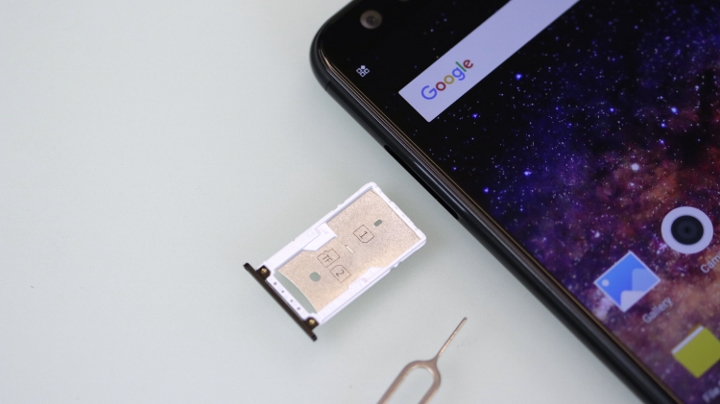
Found at the bottom are the 3.5mm audio port, microphone, loudspeaker, and micro USB which is a bit weird considering that some more affordable phones are now using USB Type-C.

Flip it on its back and you will see the 13MP and 5MP rear cameras, LED flash, and the fingerprint sensor.

In the hands, the Quattro feels tall and wider than most devices but can be held comfortably with one hand. Navigation, though, would still require you to use two hands.

It feels well-built and hefty, which is understandable considering the large 4,010mAh battery. It’s relatively slim, and it feels premium thanks to its metallic metal body, while the 2.5D Gorilla Glass on the top curves nicely to the bezel. If you’re worried about getting scratches on your device, don’t, as it comes with a screen protector and a jelly case in the package which is good.
The Quattro sports a 6-inch screen, which Cloudfone calls this the Infinite Vision Display, has an above average screen size but not uncommon in smartphones nowadays. The HD+ (1440 x 720) resolution can be a downer considering the large display, but the 268ppi pixel density is more than enough for most uses like gaming and watching videos. It’s bright, with accurate colors, and good viewing angles.

The 18:9 aspect ratio is a big plus as well as it allows the Quattro to have slim top and bottom bezels with a good screen-to-body ratio. Mounted on top if it is a 2.5D Corning Gorilla Glass 3 for protection.
The down-firing loudspeaker is powered by Waves MaxxAudio. Quality is loud and crisp with weak bass, but good enough for some casual listening, hands-free voice calls, and gaming.
One of the main features of the Quattro is its cameras. It has a total of four shooters – 13MP + 5MP rear and 20MP + 8MP wide-angle. It’s loaded with features like Face Beauty, HDR, Panorama, Professional, Time-lapse, Slow motion, Bokeh, and GIF, to name a few.

Image quality is surprisingly good for a smartphone in this price range. Shots from the 13MP rear camera are sharp, with plenty of details, and accurate colors, especially when shooting in bright environments. Indoor performance is a bit off though as it tends to overexpose subjects even when there’s sufficient light. As for the 5MP secondary, it’s just there to assist the main camera to achieve the Bokeh effect.

The front cameras, on the other hand, have different tricks. The main camera has a 20MP resolution for sharp selfies and features face tracking. Like with the rear camera, quality is also good and sports an LED flash for selfies in the dark. For those who are fond of group selfies, this is where the 8MP wide-angle comes to play. Although the resolution is not as high as the main selfie camera, quality is good enough for social media upload and is capable of getting more subjects in the shot.
When it comes to video recording, the Quattro maxes out at 1080p, 30fps, in 3GP format. Quality is average with obvious oversharpening but has good dynamic range and colors. Watch the sample video below.
Running the software department is Android 7.0 Nougat skinned with Cloudfone’s own interface and icons which feels outdated, but you can easily remedy that by downloading your favorite launcher from the App Store. It has multiple home screens to house all apps and uses on-screen navigation buttons.
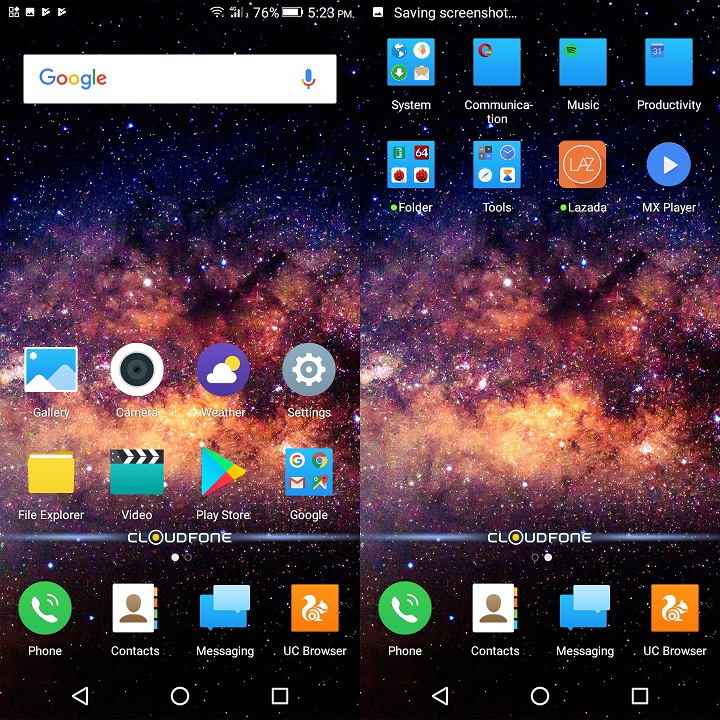
Swiping down from the top reveals the notifications drawer while swiping up from the bottom would reveal the shortcut keys. Other features include Smart Eye Protection, Split Screen, Data Clone, Child Mode, and Theme Park.

Pre-installed apps are present but most are from Google. Others include Opera Mini, UC Browser, Spotify, and Lazada, which you can uninstall. All in all, this leaves you with 52.61GB of usable space out of the 64GB. You can expand it via microSD card or USB OTG.
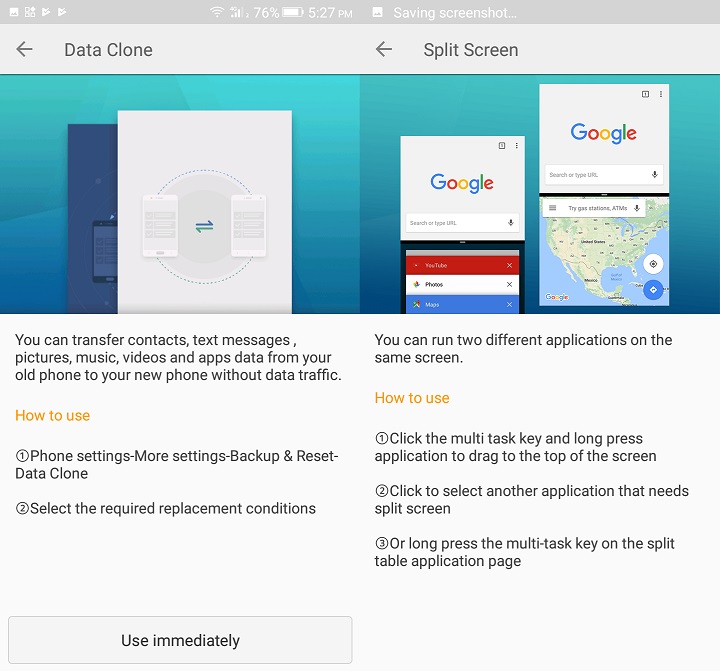
In addition to the apps mentioned, it has the Cloudfone App Shop and Cloudfone Care where you can get OTA updates, connect to their Customer Care department, provide feedback, and receive Cloudfone news.
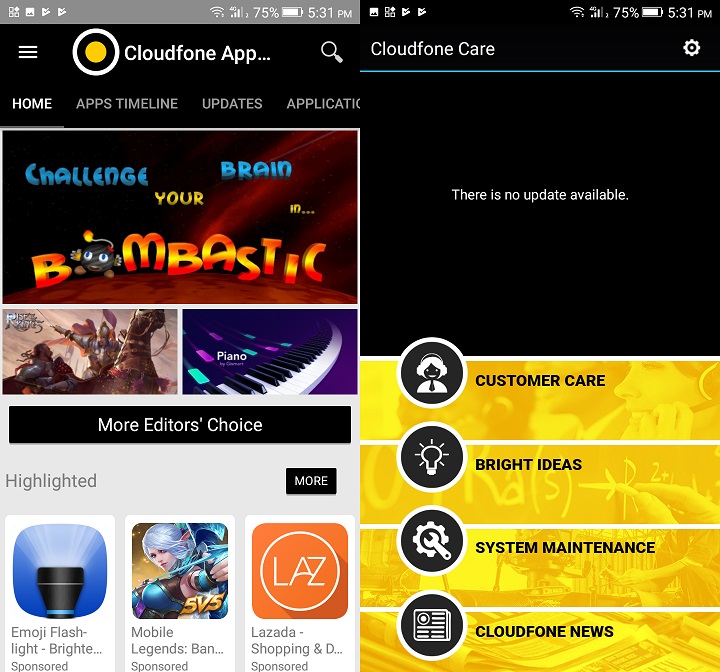
From here, you can also do a system maintenance check to see if there are any problems. It’s funny though that it already has found a security threat but requires you to install Dr. Safety before you can remove it.
Powering the Quattro is a MediaTek Helio P25 octa-core processor clocked at 2.6GHz which is the same processor powering the Meizu Pro 7 (Standard) and Doogee Mix. This is accompanied by a Mali T880 GPU and 4GB RAM. Performance is not an issue as apps launch fast, animations are smooth, the fingerprint sensor is responsive, and switching between apps is a breeze.
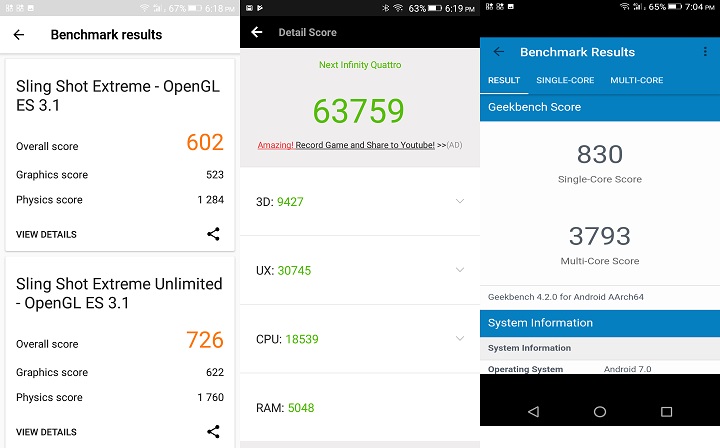
Gaming shouldn’t be a problem as it was able to run games like Mobile Legends and Arena of Valor in their highest settings. Warming can be felt at the backside in the middle but it is nothing to be worried about. Check out the benchmark scores below:
The Quattro packs dual-SIM with 4G LTE, WiFi, Bluetooth, GPS, and Gyroscope. We didn’t encounter issues with any of these features we experienced good call quality, fast mobile data, and accurate GPS signal.
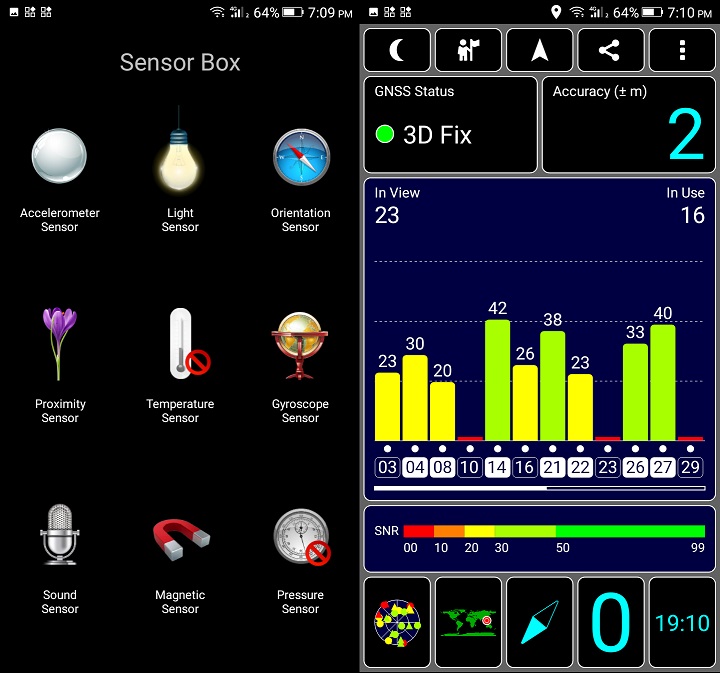
When it comes to battery life, the Quattro can last longer than most smartphones thanks to its 4,010mAh battery. It was able to last us for about 2 days of mixed usage consisting of heavy social media on WiFi, photography, and some gaming. PC Mark rated its battery life at 14 hours and 54 minutes while our video loop test yielded 14 hours and 16 minutes of playback which is good. Charging, on the other hand, takes about 3 hours.
Cloudfone’s Next Infinity Quattro is not just the result of the company’s effort to provide its customers with a good, reasonably-priced device but it is also a sign of the company’s commitment to improving its product line. For Php12,999USD 222INR 18,778EUR 211CNY 1,613, you’re getting a smartphone with features normally found in more expensive offerings – a large 18:9 display, slim bezels, good quad cameras, decent performance, and a large battery. If you’re looking for a device that has those pros without breaking the breaking the bank, the Next Infinity Quattro is the one to get.
Cloudfone Next Infinity Quattro specs:
6-inch HD+ (1440 x 720) 18:9 display
2.5D Corning Gorilla Glass
MediaTek Helio P25 2.6GHz octa-core CPU
Mali T880 GPU
4GB RAM
64GB storage
up to 256GB via microSD
13MP + 5MP rear camera w/ 2x zoom, bokeh effect, LED flash
20MP + 8MP front wide-angle camera
Dual-SIM
4G LTE, 700MHz
WiFi
Bluetooth
GPS, A-GPS
OTG
Gyroscope
Fingerprint sensor
Android 7.0 Nougat
4,010mAh battery w/ reverse charging
What we liked:
* Large screen
* Good rear and front cameras
* Decent performance
* Long battery life
* Competitive price
What we didn’t:
* Low-resolution display
* No fast charging
* No USB Type-C

YugaTech.com is the largest and longest-running technology site in the Philippines. Originally established in October 2002, the site was transformed into a full-fledged technology platform in 2005.
How to transfer, withdraw money from PayPal to GCash
Prices of Starlink satellite in the Philippines
Install Google GBox to Huawei smartphones
Pag-IBIG MP2 online application
How to check PhilHealth contributions online
How to find your SIM card serial number
Globe, PLDT, Converge, Sky: Unli fiber internet plans compared
10 biggest games in the Google Play Store
LTO periodic medical exam for 10-year licenses
Netflix codes to unlock hidden TV shows, movies
Apple, Asus, Cherry Mobile, Huawei, LG, Nokia, Oppo, Samsung, Sony, Vivo, Xiaomi, Lenovo, Infinix Mobile, Pocophone, Honor, iPhone, OnePlus, Tecno, Realme, HTC, Gionee, Kata, IQ00, Redmi, Razer, CloudFone, Motorola, Panasonic, TCL, Wiko
Best Android smartphones between PHP 20,000 - 25,000
Smartphones under PHP 10,000 in the Philippines
Smartphones under PHP 12K Philippines
Best smartphones for kids under PHP 7,000
Smartphones under PHP 15,000 in the Philippines
Best Android smartphones between PHP 15,000 - 20,000
Smartphones under PHP 20,000 in the Philippines
Most affordable 5G phones in the Philippines under PHP 20K
5G smartphones in the Philippines under PHP 16K
Smartphone pricelist Philippines 2024
Smartphone pricelist Philippines 2023
Smartphone pricelist Philippines 2022
Smartphone pricelist Philippines 2021
Smartphone pricelist Philippines 2020
garu says:
how about heat problem?
Louie Diangson says:
We didn’t encounter any heat problem.
???????? says:
Dimensions?
ryielheart says:
Compared to Huawei’s Nova 2i, which is better? Hoping for your input. :)